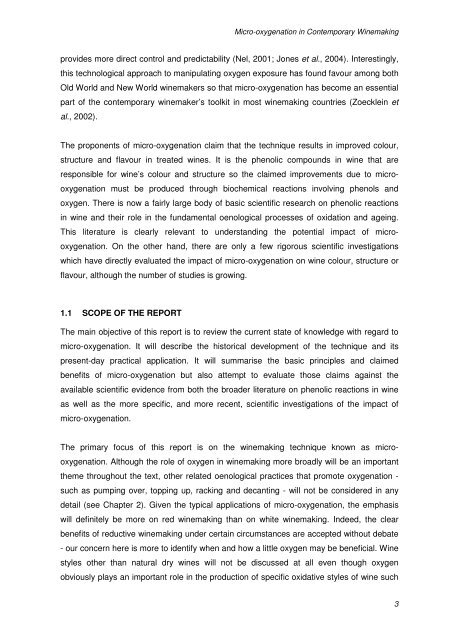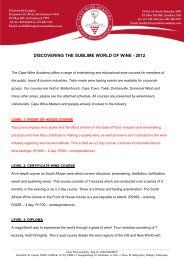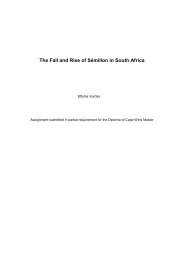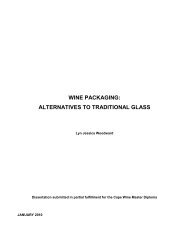micro-oxygenation in contemporary winemaking - Cape Wine ...
micro-oxygenation in contemporary winemaking - Cape Wine ...
micro-oxygenation in contemporary winemaking - Cape Wine ...
You also want an ePaper? Increase the reach of your titles
YUMPU automatically turns print PDFs into web optimized ePapers that Google loves.
Micro-<strong>oxygenation</strong> <strong>in</strong> Contemporary W<strong>in</strong>emak<strong>in</strong>gprovides more direct control and predictability (Nel, 2001; Jones et al., 2004). Interest<strong>in</strong>gly,this technological approach to manipulat<strong>in</strong>g oxygen exposure has found favour among bothOld World and New World w<strong>in</strong>emakers so that <strong>micro</strong>-<strong>oxygenation</strong> has become an essentialpart of the <strong>contemporary</strong> w<strong>in</strong>emaker’s toolkit <strong>in</strong> most w<strong>in</strong>emak<strong>in</strong>g countries (Zoeckle<strong>in</strong> etal., 2002).The proponents of <strong>micro</strong>-<strong>oxygenation</strong> claim that the technique results <strong>in</strong> improved colour,structure and flavour <strong>in</strong> treated w<strong>in</strong>es. It is the phenolic compounds <strong>in</strong> w<strong>in</strong>e that areresponsible for w<strong>in</strong>e’s colour and structure so the claimed improvements due to <strong>micro</strong><strong>oxygenation</strong>must be produced through biochemical reactions <strong>in</strong>volv<strong>in</strong>g phenols andoxygen. There is now a fairly large body of basic scientific research on phenolic reactions<strong>in</strong> w<strong>in</strong>e and their role <strong>in</strong> the fundamental oenological processes of oxidation and age<strong>in</strong>g.This literature is clearly relevant to understand<strong>in</strong>g the potential impact of <strong>micro</strong><strong>oxygenation</strong>.On the other hand, there are only a few rigorous scientific <strong>in</strong>vestigationswhich have directly evaluated the impact of <strong>micro</strong>-<strong>oxygenation</strong> on w<strong>in</strong>e colour, structure orflavour, although the number of studies is grow<strong>in</strong>g.1.1 SCOPE OF THE REPORTThe ma<strong>in</strong> objective of this report is to review the current state of knowledge with regard to<strong>micro</strong>-<strong>oxygenation</strong>. It will describe the historical development of the technique and itspresent-day practical application. It will summarise the basic pr<strong>in</strong>ciples and claimedbenefits of <strong>micro</strong>-<strong>oxygenation</strong> but also attempt to evaluate those claims aga<strong>in</strong>st theavailable scientific evidence from both the broader literature on phenolic reactions <strong>in</strong> w<strong>in</strong>eas well as the more specific, and more recent, scientific <strong>in</strong>vestigations of the impact of<strong>micro</strong>-<strong>oxygenation</strong>.The primary focus of this report is on the w<strong>in</strong>emak<strong>in</strong>g technique known as <strong>micro</strong><strong>oxygenation</strong>.Although the role of oxygen <strong>in</strong> w<strong>in</strong>emak<strong>in</strong>g more broadly will be an importanttheme throughout the text, other related oenological practices that promote <strong>oxygenation</strong> -such as pump<strong>in</strong>g over, topp<strong>in</strong>g up, rack<strong>in</strong>g and decant<strong>in</strong>g - will not be considered <strong>in</strong> anydetail (see Chapter 2). Given the typical applications of <strong>micro</strong>-<strong>oxygenation</strong>, the emphasiswill def<strong>in</strong>itely be more on red w<strong>in</strong>emak<strong>in</strong>g than on white w<strong>in</strong>emak<strong>in</strong>g. Indeed, the clearbenefits of reductive w<strong>in</strong>emak<strong>in</strong>g under certa<strong>in</strong> circumstances are accepted without debate- our concern here is more to identify when and how a little oxygen may be beneficial. W<strong>in</strong>estyles other than natural dry w<strong>in</strong>es will not be discussed at all even though oxygenobviously plays an important role <strong>in</strong> the production of specific oxidative styles of w<strong>in</strong>e such3
















